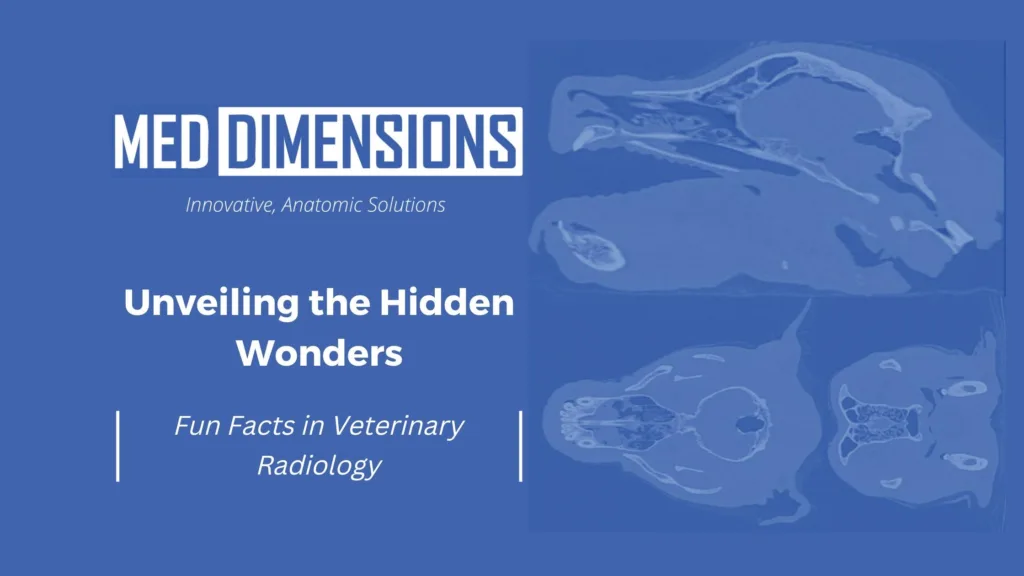Unveiling Hidden Wonders: Fun Facts About Radiology

Veterinary radiology is a fascinating field that often goes unnoticed in the grand scheme of healthcare. However, it plays a crucial role in ensuring the well-being of our beloved animal companions. As we delve into the world of veterinary radiology, you’ll discover a realm of surprising facts that highlight the advanced technology, skilled professionals, and the profound impact it has on our furry, feathered, and scaly friends. From X-rays revealing hidden mysteries to the extraordinary ways in which this discipline has evolved, join us on a journey through the captivating and intriguing world of veterinary radiology. In this blog, we’ll explore some of the most remarkable insights into this specialized branch of veterinary medicine, giving you a deeper appreciation for the dedicated individuals who make it all possible.
- Non-Destructive Testing: Radiology in veterinary medicine is often non-destructive, which means it doesn’t require invasive procedures. This is especially beneficial for preserving the health of animals during diagnosis and treatment.
- Multislice CT: Multislice CT scanners allow for faster scanning times and higher resolution, reducing the time animals need to be under anesthesia and providing more detailed images.
- Sedation and Patience: When performing radiology on animals, particularly those that are not domesticated, sedation is often required. Radiologists and veterinary technicians need a great deal of patience and skill to get the necessary images.
- Minimally Invasive Procedures: CT-guided interventions, such as needle biopsies and fluid aspiration, are increasingly common in veterinary medicine. They offer minimally invasive ways to obtain diagnostic samples.
- Feathered and Scaled Friends: In addition to traditional X-rays, veterinary radiologists use specialized techniques to create images of feathers and scales. Birds and reptiles require unique imaging protocols due to their different anatomical structures.
- Avian Radiology: When taking X-rays of birds, it’s crucial to remember that their bones are often thinner and more fragile than those of mammals. Avian radiology requires lower radiation exposure and specialized techniques.
- Turtle Shells: Radiologists might need to take images of the inside of a turtle’s shell. The shell is composed of living tissue, and radiographs can help identify infections or injuries that aren’t visible from the outside.
- Hoof Radiographs: Radiographs of hooves are common in equine medicine. They help diagnose conditions like laminitis, fractures, and navicular disease. Horses need to stand still with a specialized contraption for this type of imaging.
- Equine MRIs: Horses are among the most common animals to undergo MRI scans in veterinary medicine. Standing MRIs for horses are available, allowing them to be imaged while awake and standing rather than under general anesthesia.
- Teeth Tell a Tale: Dentistry is an essential part of veterinary radiology. Radiographs of an animal’s teeth can reveal dental diseases, abscesses, and hidden dental problems that may not be visible during a standard oral exam.
- Dental Radiographs for Cats and Dogs: Dental radiographs are invaluable in veterinary dentistry. They reveal issues like tooth root abscesses, fractures, and hidden cavities. Pets can’t describe dental pain, so these images are essential for their oral health.
- Advancements in Equipment: Veterinary CT technology continues to advance, with the development of smaller and more portable units, making it more accessible for use in clinics and field settings.
- Custom X-Ray Tables: Radiology tables for animals come in various shapes and sizes. For large animals like cows and horses, custom-built tables with weight-bearing capabilities are used to safely and comfortably position the animals for imaging.
- Radiography in Marine Mammals: Radiology isn’t limited to land animals. It’s used to diagnose and treat marine mammals like dolphins and sea lions. Special portable equipment is often used in aquatic environments.
- Aquarium Residents: Fish, amphibians, and other aquatic creatures in aquariums are not exempt from veterinary radiology. Specially designed equipment and techniques are used to image these underwater residents.
- Zoo Animals: Zoo veterinarians use radiology to monitor the health of their animal residents, including large mammals, reptiles, and even primates. Routine check-ups and diagnostics are essential for maintaining the well-being of zoo animals.
- Rescue and Conservation: Radiology is employed in wildlife conservation and rescue efforts. It helps veterinarians diagnose injuries and health issues in wild animals, contributing to their rehabilitation and release.
- MRI for Exotic Pets: Exotic pets such as ferrets, rabbits, and reptiles can also benefit from MRI diagnostics. The technology is versatile enough to cater to various species, regardless of their size or unique anatomy.
- Hibernating Patients: Some animals, like hedgehogs, hibernate during the winter. Veterinary radiologists might be called upon to check the health of hibernating animals without disturbing their rest.
- Collaboration with Veterinary Specialists: Veterinary radiologists often collaborate with other specialists, such as neurologists, to provide comprehensive care for animals with complex medical issues. This interdisciplinary approach ensures the best outcomes for patients.
- Assisting in Surgery Planning: Veterinarians use CT scans to plan surgical procedures with precision. The 3D images help determine the best approach and location for incisions or the placement of surgical instruments.
As we come to the conclusion of our journey through the intriguing world of veterinary radiology, we’ve unearthed a treasure trove of remarkable facts and stories. From the powerful diagnostic capabilities of X-rays to the ever-evolving technology that continues to shape this field, we’ve seen how veterinary radiology plays a pivotal role in safeguarding the health of our beloved animal companions.